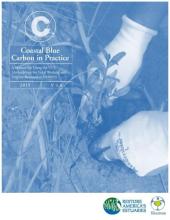
In the struggle to slow climate change, coastal wetlands are a critical asset—acre for acre, they can store up to five times as much carbon as rainforests. When wetlands are damaged or destroyed, they shift from being carbon “sinks ” to being carbon sources that release greenhouse gases into the atmosphere. Unfortunately, wetlands are disappearing at an alarming pace, and decisions to develop, protect, or restore them are often made in the context of limited public resources. Trading wetlands carbon offsets on carbon markets is an exciting new approach to creating financial incentives for restoration and conservation. To help “bring wetlands to market, ” the Waquoit Bay Reserve led a cutting-edge, collaborative research project in 2011 that examined the relationship between salt marshes, climate change, and nitrogen pollution and developed tools to leverage the “blue carbon ” stored in wetlands to achieve broader management goals.
This manual, developed with support from the project team, outlines procedures to use the Methodology for Tidal Wetland and Seagrass Restoration, which was approved by the Verified Carbon Standard to estimate net greenhouse gas emission reductions and removals resulting from restoration of coastal wetlands. This is a first effort to outline the practical and logistical side of blue carbon project development.